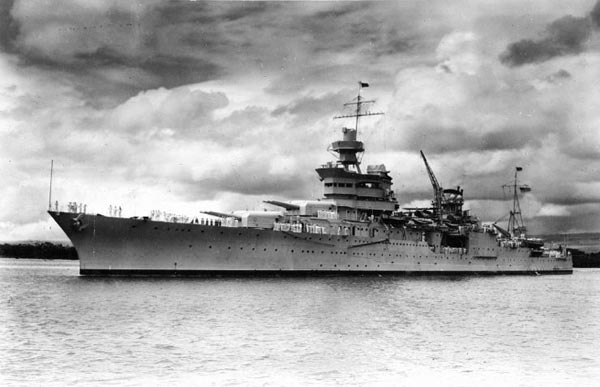THE CONTROVERSY SURROUNDING THE USS
INDIANAPOLIS TRAGEDY
USS INDIANAPOLIS, a 9,800-ton PORTLAND class heavy cruiser, was built at Camden, New Jersey. Commissioned in November 1932, she operated in the Atlantic and Pacific during the peacetime years. During the 1930s, she hosted President Franklin D. Roosevelt on several occasions, among them a voyage to South America in November and December 1936.
Following the U.S. entry into World War II, the Indianapolis operated with carrier task forces in the southwestern Pacific until Spring 1942, when she took up station in the Alaska area. She served there for over a year, sinking a Japanese transport in February 1943. Later in 1943, Indianapolis became Fifth Fleet flagship. In that roll, into mid-1944, she took part in operations to capture the Gilberts, Marshalls, and Marianas, plus strikes on Japanese positions elsewhere in the central Pacific. She also participated in the Peleliu invasion in September 1944.
In February and March 1945, Indianapolis, again flagship of the Fifth Fleet, joined in attacks on Iwo Jima, the Japanese home islands and the Ryukyus. During the latter operation, on 31 March 1945, she was damaged by a Kamikaze plane. In late July, following repairs, Indianapolis made a high speed transit from California to Tinian to deliver atomic bomb components of "LITTLE BOY", which would be dropped on Hiroshima , the battle cruiser USS Indianapolis was torpedoed in the South Pacific by the Japanese submarine I-58 and sank quickly.
An estimated 300 men were killed upon impact; close to 900 sailors were cast into the Pacific Ocean, where they remained, undetected by the Navy, for nearly five days. Battered by a savage sea, they struggled to survive, fighting off hyperthermia, sharks, physical and mental exhaustion, and, finally, hallucinatory dementia. By the time rescue-which was purely accidental-arrived, all but 321 men had lost their lives; 4 more would die in military hospitals shortly thereafter.
The captain's subsequent and highly unusual court-martial left many questions unanswered: How did the Navy fail to realize the Indianapolis was missing? Why was the cruiser traveling unescorted in enemy waters? And perhaps most amazing of all, how did these 317 men manage to survive?
 USS INDIANAPOLIS at Pearl Harbor U.S. Naval Historical Center |
 USS INDIANAPOLIS OFFICERS AND CREW U.S. Naval Historical Center |
 INDIANAPOLIS PILOTHOUSE U.S. Naval Historical Center |